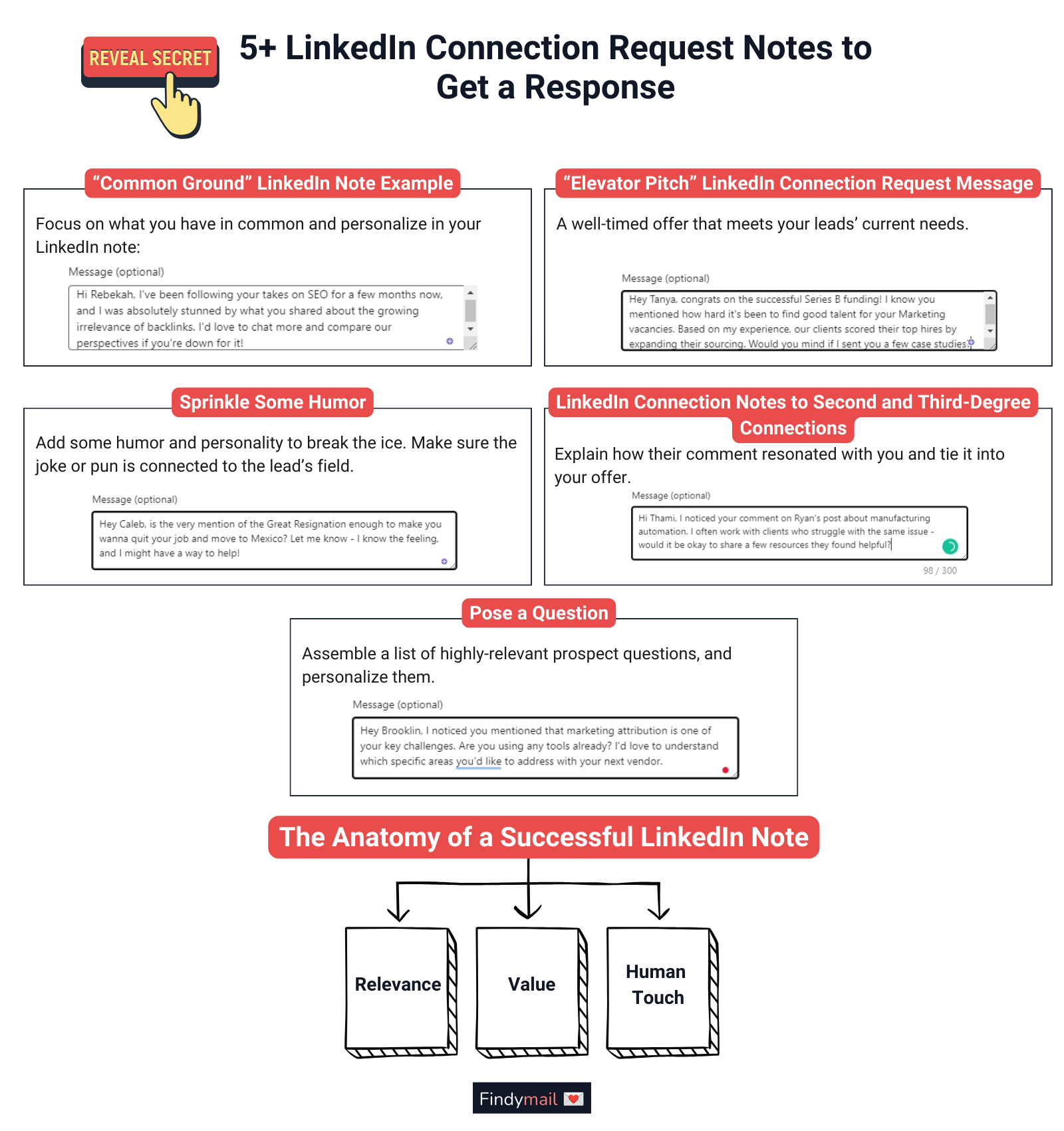If I had a cent for every time I received a connection request on LinkedIn without a note or a hint of what this person wants from me, I’d be writing this post from the Moon. Unfortunately, LinkedIn notes aren’t a required part of the connection request process, but they should be.
Today, I’ll walk you through the best LinkedIn connection request notes you should use if you want to:
- Connect with the right people (leads)
- Start relationships off on the right foot
- Stand out from the sea of nameless connection requesters
Ready? Let’s dive in!

- The “Common Ground” LinkedIn Note Example
Suppose you’re looking for leads among LinkedIn alumni or want to connect with a prospect who’s the perfect fit for your offer. Do you just fire off a connection request and hope for the best?
Oh no, you don’t!
Instead, you focus on what you have in common in your LinkedIn note:
- Did you go to the same school?
- Have you read some of their posts, and they resonated with you?
- Do you have an interest in their area of expertise?
Yes, you’ll need to personalize your LinkedIn note and do your research first. But if you want to connect with someone, LinkedIn has a connection request limit, so I’m presuming they’re important enough you want to stay in touch with them.
(Don’t want to stay in touch with the lead; just convert them? No problem. Circumvent it by getting their email address off LinkedIn with Findymail, and shooting them an email.)
2. The “Elevator Pitch” LinkedIn Connection Request Message
Ideally, you shouldn’t pitch before someone gets to know you, but there’s nothing wrong with a well-timed offer if it meets your leads’ current requirements.
For example, maybe you’ve kept track of the changes in the lead’s company and noticed they recently received funding. Now, they’re doubling down on hiring, and you happen to work for a recruitment agency.
LinkedIn Notes give you fewer characters to work with. However, it’s still good to have a strong icebreaker that proves how you can specifically help this lead, be that by referencing your experience, case studies, or other points relevant to their current challenges.
Your “elevator pitch” LinkedIn note has three duties:
- It has to prove it’s personal to the lead.
- It has to be as specific as possible, referencing particular challenges and goals.
- It has to demonstrate your expertise and track record.
A generic LinkedIn note won’t convert anyone (but it’s still better than no note).
3. Sprinkle Some Humor
Most LinkedIn notes where you try to pitch something to someone are so dry that even the Sahara would get jealous. Just because your offer corresponds with the member’s needs doesn’t mean you have to take your LinkedIn note so seriously.
Instead, add some humor and personality to break the ice. Make sure the joke or pun is connected to the lead’s field.
In the example above, I wanted to connect with an HR professional.
However, you can get inside jokes and memes for pretty much any field just by googling them: “[role] + meme” or “[role] + joke.
4. LinkedIn Connection Notes to Second and Third-Degree Connections
How do you know when a lead is ready to talk about your solutions? In some cases, you might notice their comment on a shared connection’s post.
When you’re dealing with a second or third-degree connection and they’re a good fit, approach the LinkedIn note carefully:
- Remind them where you noticed their comment
- Explain why it resonated with you
- Describe how you can help
Feel free to go into more detail where appropriate, but be mindful of the character limit and offer a promise of value to keep the conversation going.
5. Pose a Question
Another approach you can take with LinkedIn Notes is to assemble a list of highly-relevant prospect questions, and then personalize them depending on the user.
For example, suppose your prospect is Head of Marketing and they frequently talk about marketing attribution as one of their key challenges. Lucky you because that’s your industry and you now know their pain point.
You could connect with them, asking why their current solutions aren’t working.
Similarly, if you frequently work with one type of industry, leverage your knowledge of problem areas. For example, in the automotive industry, excess production post-COVID-19 is a huge problem for pretty much any company. Start the conversation by establishing you understand the landscape they do business in.
Now, at this point you’re probably realizing that writing a LinkedIn connection request note that gets a response is a matter of three things…
The Anatomy of a Successful LinkedIn Note
1.Relevance
Time your note to when your leads are most susceptible to your offer. Look at different signals (their engagement, company news, posts and comments) to know when the time is right.
Then, establish your expertise and understanding of their specific problems. Don’t pitch them offering to increase their revenue.
Instead, find out what’s stopping them from increasing revenue right now, and pitch with that in mind.
2.Value
What do they get out of connecting with you? Chances are, your leads get dozens of connection requests every day. Yours will stand out because of the note but most importantly, your note is a chance to establish the right foundations for the relationship.
Once you’ve proven that you understand their problem, hint at the value they can get by becoming your connection. This can be your involvement in their industry or track record.
3.The Human Touch
Finally, don’t forget that leads are so used to bulk emails and messages that decent personalization makes a world of difference.
Take the time you need to research the lead and always show them you familiarized yourself with their posts.
Don’t forget to be you. Thank them after accepting the request, reference humor in the note (where appropriate), and consider sending a follow-up LinkedIn voice message.
After all, if a prospect is special enough to warrant a connection request - and not just a cold email or an InMail message - nurture them.
If you play your cards right, you’ll soon have a happy new customer!






